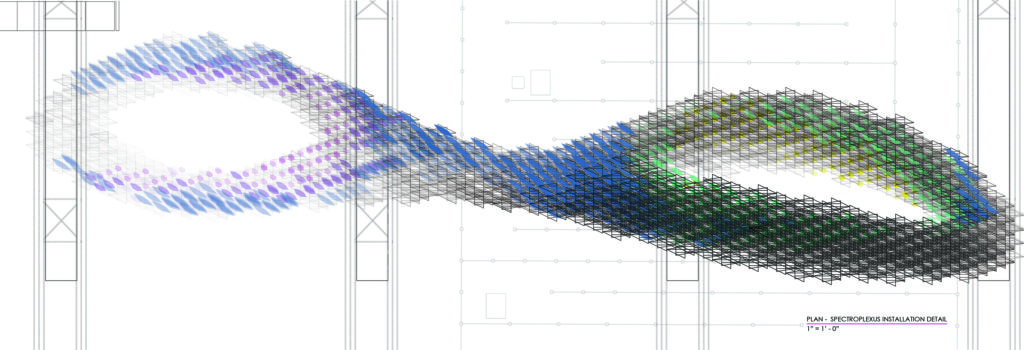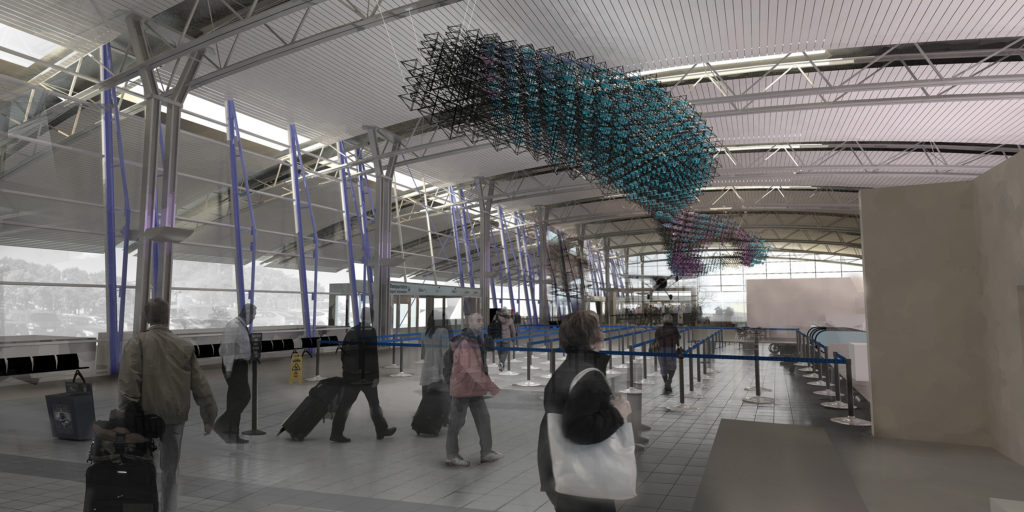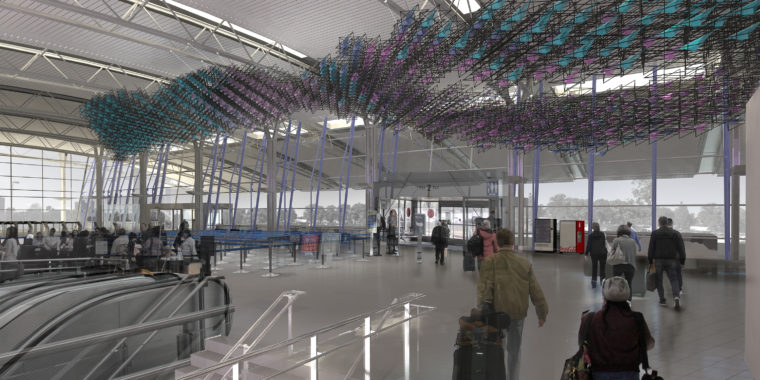How do you create an artwork light enough to hang from the ceiling but substantial enough to fill an airport terminal?
Over the last four months, eight students in the Graduate School of Architecture & Urban Design at Washington University in St. Louis have digitally designed, modeled and constructed prototypes for “Spectroplexus,” a new, 100-foot-long public sculpture that is being commissioned by St. Louis Lambert International Airport.
Now students are gearing up to complete the piece, which will be installed on the south side of Terminal 2, above the ticketing lobby. The team will finalize design, begin fabrication and install the work on-site by the end of May.
“It’s an enormous space,” said Lavender Tessmer, a lecturer in the Sam Fox School of Design & Visual Arts, who teaches digital fabrication with fellow lecturer Jason Foster Butz. “That’s probably the biggest challenge. To have visual impact, the piece has to be really large.”
“’Spectroplexus’ was born out of a collaboration between Washington University and the Lambert Art and Culture Program, which is dedicated to showcasing regional art, culture and design to millions of travelers and visitors each year,” said Jeff Lea, the art program’s coordinator and airport spokesman. “It’s been amazing to watch this project from the ground up to see the design and innovation engineered into what should be an amazing, ‘airborne’ sculpture.”

Hybrid nature
“Structural Substances: Suspended in Air” is the latest in a series of digital fabrication studios taught by Tessmer and Butz. In 2015, their students conceived, designed and assembled “ACCUMULUS,” a temporary outdoor installation commissioned by the Contemporary Art Museum St. Louis.
The new project, which will remain on view at the airport for 12-18 months, employs a similar approach and construction techniques. Translucent polycarbonate sheets, dyed with shades of pink and purple, will be suspended within a thin, wire-like lattice of hardened carbon fiber. In design renderings, the piece seems to undulate across the ceiling. Colors emerge softly, like clouds fringed by the rays of the setting sun.
“The concept is based on the hybrid nature of flying machines,” Tessmer explained. “The wing of an airplane is a mechanized form, but it’s also a shape — like the wing of a bird — that we understand from the natural world.
“That idea is reflected in the materials we chose,” she continued. “Carbon fiber is strong, rigid and lightweight, but it also behaves a little unpredictably. There’s variability in the geometry. Polycarbonate is more predictable — it cuts the same every time — but the colored inks we’re using dry very quickly, which gives the panels a lot of texture.
“The project combines elements we can control really well with elements that have a lot more natural variation,” Tessmer added. “Though it has been digitally designed and fabricated, you’ll also see evidence that it has been worked by hand.”

Clever management, complex results
“Spectroplexus” will be built from approximately 2,000 subassemblies, each measuring about a foot in length. Once on-site, they’ll be joined together to form a single flowing, wavelike structure.
“Part of the premise of the studio is to develop processes that produce complex results through the clever management of more manual technologies,” Butz said. “Each part must be calibrated not only against the digital model and the tools used to produce them, but against each other.”
“Coordinating these elements at a detail scale has proven to be the most difficult aspect of the project,” Butz added, “but the students are rising to the occasion.”
To build the subassemblies, which are based on a rhombic grid, students will wrap spools of flexible carbon fiber around collapsible molds, which they will fabricate on computer numerical control (CNC) mills at TechShop, a makerspace and DIY fabrication studio in Cortex. The carbon-wrapped molds then will bake inside industrial powder-coating ovens for about 90 minutes, stiffening the fibers enough to support the polycarbonate panels. These in turn will be cut using a 2D knife plotter in the Sam Fox School’s Digital Fabrication Lab.
“’Structural Substances’ is part of a series of works, led by Lavender and Jason, that produce hybrid assemblies of analog and digital structures,” said Heather Woofter, professor and chair of graduate architecture. It is also part of a larger initiative, coordinated by the school’s Office for Socially Engaged Practice, to promote community relationships through design projects.
“Students interface with clients and experience fabrication challenges unique to built works,” Woofter explained. “In addition to taking on socially complex challenges in architecture, faculty and students are empowered to engage cultural venues to develop theoretical positions and consider unique approaches to practice.”

Schedule and installation
On May 3, students met with the St. Louis Lambert team and members of its Airport Art Advisory Committee for a final design review.
“The students have researched, monitored and evaluated every factor of the terminal space to guide and inspire their design, construction and materials,” Lea said. “The design speaks to our region and it evokes themes of airports, people and flight. We look forward to seeing thousands of passengers looking up, purposefully, toward the ceiling and to get a glimpse of this new work of art.”
Over the next three weeks, students will work to fabricate the subassemblies, at the rate of about 100-150 per day. Installation will take place in late May, primarily during late evening and early morning hours, to avoid inconveniencing travelers.
Organizers hope to complete installation of “Spectroplexus” by Memorial Day — one of the busiest travel weekends of the year.
“This is a highly trafficked public space,” Butz concluded. “Millions of people pass through annually, while entering or leaving St. Louis.
“Hopefully this project will add to the quality of their experience.”
The graduate architecture students in the studio are: Daniel Ho, Gregory Smolkovich, Yigang Li, Marija Draskic, Rachel Burch, Michael Zhou, Ellie Sonnenwirth Weisz and Samantha Brown.
For information, visit samfoxschool.wustl.edu or follow the school on Facebook and Twitter.

